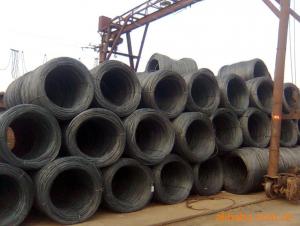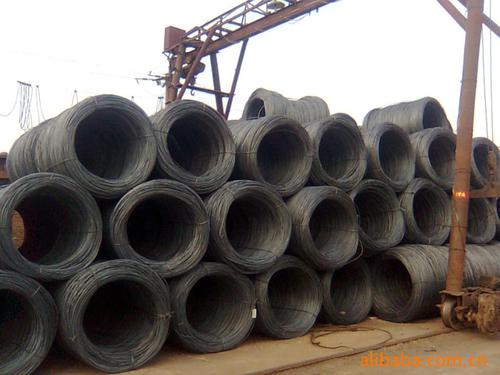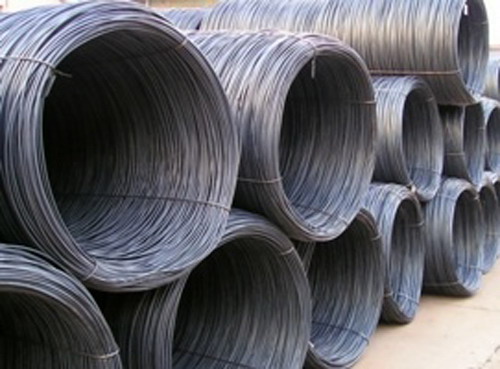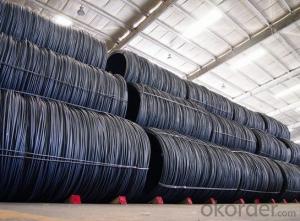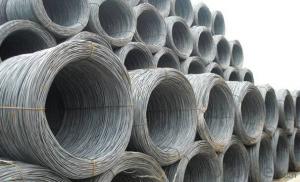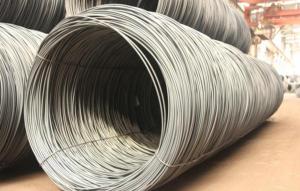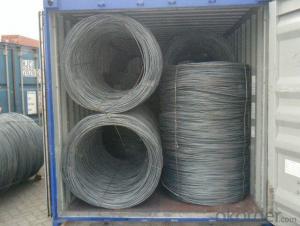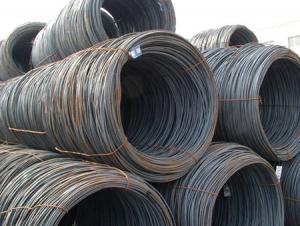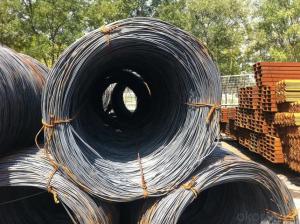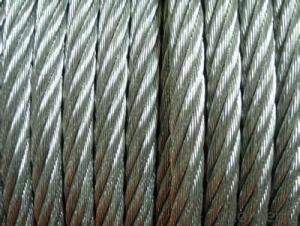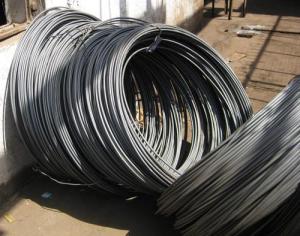Wire rod SAE1008B
- Loading Port:
- China Main Port
- Payment Terms:
- TT OR LC
- Min Order Qty:
- -
- Supply Capability:
- -
OKorder Service Pledge
OKorder Financial Service
You Might Also Like
Wire Rod Q235 Details:
| Minimum Order Quantity: | 25 Tons | Unit: | m.t. | Loading Port: | XINGANG PORT,China |
| Supply Ability: | 100,000 Tons Per Month | Payment Terms: | TT or LC |
Product Description:
Specifications of Wire Rod Q235:
Steel Grade: Q235, Standard: GB Diameter: 5.5mm, 6.5mm, 7mm,8mm,9mm,10mm,12mm,14mm
Diameter Tolerance:±0.3mm 6.5mm can be drawing into 2mm/8.0mm can be drawing into 3mm
Brand Name: N-RIVER Place of Origin: Hebei, China Mainland Application: construction, building etc
Chemical Composition:
Please kindly find our chemistry of our material based on Q235 as below for your information
Trademark | Rank | Chemical composition (quality score) % | |||||
C | Si | Mn | S | P | |||
| ≤ |
| ≤ | ≤ | |||
Q235 | A | 0.14-0.22 | 0.30 | 0.30-0.65 | 0.050 | 0.045 | |
Q235 | B | 0.12-0.20 | 0.30 | 0.30-0.70 | 0.045 | 0.045 | |
Trademark | Rank | Pulling Test | |||||
Bend PointΔs/Mpa | Tensile Strength | Elongation Ratioδ5% | |||||
Thickness (Diameter) /MM | Thickness (Diameter) /MM | ||||||
≤16 | 16-40 | ≤16 | 16-40 | ||||
≥ | ≥ | ||||||
Q235 | A | 235 | 225 | 375-500 | 26 | 25 | |
Q235 | B | 235 | 225 | 375-500 | 26 | 25 | |
Usage and Applications of Wire Rod Q235:
After hot-rolled the products shaped into coil and delivery as finished product, including round, square, rectangular, hexagonal and so on. Since most of the products are round, it is generally called wire rod. Carbon steel wire rod is widely used in construction and manufacturing. Carbon steel wire rod is mainly used for reinforcement of reinforced concrete and welded structure or reprocessed (roberts , nail, etc.) materials, especially used to produce wire drawing, welding electrode, nails, spring, electronic, precise machinery parts and so on.
Packaging & Delivery of Wire Rod Q235:
Packaging Detail: products are packed in coil and then shipped by container or bulk vessel
Each coil weight: 2-3MT
Delivery Detail: within 45 days after received deposit or LC.
Label: to be specified by customer, generally, each bundle has 1-2 labels
Trade terms: FOB, CFR, CIF
- Q: What are the different corrosion resistance properties of steel wire rod?
- The different corrosion resistance properties of steel wire rod depend on various factors such as the composition of the steel, the presence of alloying elements, surface treatment, and environmental conditions. Some steel wire rods have high corrosion resistance due to the presence of elements like chromium, nickel, or molybdenum, which form a protective layer on the surface of the metal. Other factors, such as the presence of impurities, surface defects, or exposure to corrosive environments, can reduce the corrosion resistance of steel wire rods.
- Q: How is steel wire rod used in the manufacturing of piano wire?
- Steel wire rod is an essential material used in the manufacturing of piano wire due to its strength, durability, and flexibility. Piano wire, also known as music wire, is a high-tensile steel wire that is primarily used in the construction of piano strings but also finds application in various other industries such as aerospace, automotive, and medical. To produce piano wire, steel wire rod is first subjected to a series of manufacturing processes. The rod is cleaned and descaled to remove any impurities or surface contaminants. It is then heated to a specific temperature to improve its malleability and make it easier to work with. Next, the steel wire rod is drawn through a series of dies to gradually reduce its diameter. This process, known as wire drawing, involves pulling the rod through a die with a smaller hole size, which elongates and thins the rod while increasing its strength and tensile properties. This drawing process is repeated multiple times until the desired wire thickness is achieved. Once the desired thickness is obtained, the wire is further heat-treated to enhance its mechanical properties. This heat treatment process, known as patenting, involves heating the wire to a specific temperature and then cooling it rapidly to increase its strength, elasticity, and resistance to deformation. After the patenting process, the wire is carefully inspected for any defects or imperfections. Any flawed wire is discarded to ensure the final product maintains the highest quality standards. The resulting steel wire, now in the form of piano wire, possesses exceptional tensile strength, allowing it to withstand the high tension required for piano strings. Its inherent flexibility enables it to vibrate freely, producing the rich and resonant tones associated with high-quality pianos. In summary, steel wire rod is a critical component in the manufacturing of piano wire due to its strength, durability, and flexibility. Through a series of manufacturing processes such as cleaning, heating, wire drawing, and heat treatment, the wire rod is transformed into a high-tensile steel wire that can withstand the demanding requirements of piano strings.
- Q: What are the common sizes of steel wire rod?
- The size of steel wire rods differs depending on the specific application and industry requirements. However, there are commonly utilized sizes of steel wire rods with diameters ranging from 5.5mm to 20mm. These sizes are typically employed in the production of various items, including wire ropes, springs, nails, screws, and reinforcement bars for construction purposes. Moreover, steel wire rods can also be found in larger diameters that exceed 20mm, which are suitable for heavy-duty applications such as prestressed concrete structures and suspension bridges. It is worth noting that the sizes of steel wire rods can vary by region and industry standards, so it is advisable to refer to the relevant specifications and standards for accurate information.
- Q: What are the main factors affecting the worker safety in steel wire rod production?
- The main factors affecting worker safety in steel wire rod production include hazardous machinery, exposure to high temperatures and molten metal, chemical hazards, heavy lifting and manual handling, noise and vibration, and inadequate personal protective equipment. Additionally, poor ergonomics, lack of proper training and supervision, fatigue, and potential for falls and slips contribute to the safety risks in this industry. Proper safety protocols, regular maintenance of equipment, and implementing comprehensive safety training programs are crucial to mitigate these factors and ensure worker safety in steel wire rod production.
- Q: What are the typical dimensions of steel wire rod?
- The typical dimensions of steel wire rod vary depending on the specific application and industry standards. However, common diameters range from 5.5mm to 14mm, and lengths typically range from 2,000mm to 4,000mm.
- Q: How is steel wire rod used in the manufacturing of wire for high-speed trains?
- Steel wire rod is used in the manufacturing of wire for high-speed trains because of its strength, durability, and ability to withstand high tension. The steel wire rod is first processed through a series of drawing and annealing processes to achieve the desired size and mechanical properties. This wire is then used to manufacture various components of the high-speed train, including electrical wiring, traction wires, and suspension cables, ensuring safe and reliable operation at high speeds.
- Q: What are the main challenges in recycling steel wire rod?
- Recycling steel wire rod presents several primary challenges. To begin with, the collection and sorting of steel wire rod pose a major obstacle. Steel wire rod exists in various forms and sizes, making it difficult to separate from other materials during recycling. Advanced sorting technologies and efficient collection systems are necessary to ensure that only steel wire rod is recycled and other materials are appropriately sorted. Another challenge arises from the presence of contaminants in steel wire rod. Coatings like zinc or other metals frequently accompany steel wire rod and must be removed before recycling. These coatings can impede the quality of the recycled steel and may necessitate additional processing steps to guarantee the purity of the final product. Additionally, recycling steel wire rod is energy-intensive. The melting process employed in recycling requires high temperatures and consumes a substantial amount of energy. This presents challenges in terms of both cost and environmental impact, as it contributes to greenhouse gas emissions and demands significant energy resources. Moreover, the transportation and logistics involved in recycling steel wire rod can be problematic. Steel wire rod is often bulky and heavy, leading to increased transportation costs and necessitating specialized equipment for handling and processing. The logistics of collecting, transporting, and storing steel wire rod for recycling can be intricate and require efficient coordination to ensure a smooth recycling process. Lastly, fluctuations in market demand for recycled steel wire rod can create challenges for recycling facilities. The demand for steel wire rod is influenced by economic conditions, construction activities, and infrastructure development. During periods of low market demand, recycling facilities may struggle to find buyers for their recycled steel wire rod, impacting the profitability and viability of the recycling process. In conclusion, the primary challenges in recycling steel wire rod encompass collection and sorting, removal of contaminants, energy consumption, transportation and logistics, and market demand fluctuations. Addressing these challenges necessitates technological advancements, efficient processes, and a strong market demand for recycled steel wire rod.
- Q: How is steel wire rod used in the manufacturing of wire for overhead power lines?
- Steel wire rod is used in the manufacturing of wire for overhead power lines by being drawn through a series of dies to reduce its diameter. This process, known as wire drawing, helps to increase the wire's strength and flexibility. The resulting steel wire is then stranded or twisted together to form a conductor that can efficiently transmit electricity over long distances. Additionally, the steel wire's corrosion resistance and high tensile strength make it ideal for withstanding the environmental challenges and mechanical stresses associated with overhead power lines.
- Q: What are the different types of steel wire rod coatings used for high-temperature resistance?
- There are several types of steel wire rod coatings that are used for high-temperature resistance. These coatings are designed to protect the steel wire rod from oxidation, corrosion, and other forms of damage that can occur at elevated temperatures. One common type of coating used for high-temperature resistance is zinc. Zinc coatings provide excellent corrosion protection at high temperatures and are often used in applications where the steel wire rod will be exposed to extreme heat. Another type of coating that is commonly used for high-temperature resistance is aluminum. Aluminum coatings can withstand high temperatures and provide a barrier against oxidation and corrosion. Additionally, there are specialized coatings that are specifically designed for high-temperature resistance. These coatings often contain materials such as ceramic, refractory metals, or silicone-based compounds. Ceramic coatings, for example, are known for their ability to withstand extremely high temperatures and provide excellent thermal insulation. Refractory metal coatings, such as tungsten or molybdenum, are used in applications where the steel wire rod will be exposed to extremely high temperatures and harsh environments. Silicone-based coatings are known for their heat resistance and can provide a protective barrier against oxidation and corrosion. The choice of coating depends on the specific application and the desired level of high-temperature resistance. It is important to consider factors such as the operating temperature, the environment, and the level of protection required when selecting a coating for steel wire rod used in high-temperature applications.
- Q: How is the steel wire rod industry affected by government policies and regulations?
- The steel wire rod industry is significantly impacted by government policies and regulations. These policies and regulations can influence various aspects of the industry, including production, trade, pricing, and environmental standards. Governments may impose tariffs or quotas on steel wire rod imports to protect domestic producers, which can affect the competitiveness of the industry. Additionally, regulations related to labor, safety, and environmental standards can influence the operations and costs of steel wire rod producers. Government policies and regulations also play a crucial role in supporting the growth and development of the industry, such as providing incentives for research and development, infrastructure development, and promoting sustainable practices. Overall, the steel wire rod industry is highly dependent on government policies and regulations, which can shape its competitiveness, sustainability, and overall performance.
Send your message to us
Wire rod SAE1008B
- Loading Port:
- China Main Port
- Payment Terms:
- TT OR LC
- Min Order Qty:
- -
- Supply Capability:
- -
OKorder Service Pledge
OKorder Financial Service
Similar products
Hot products
Hot Searches
Related keywords
